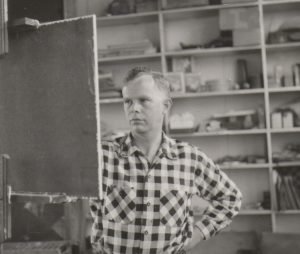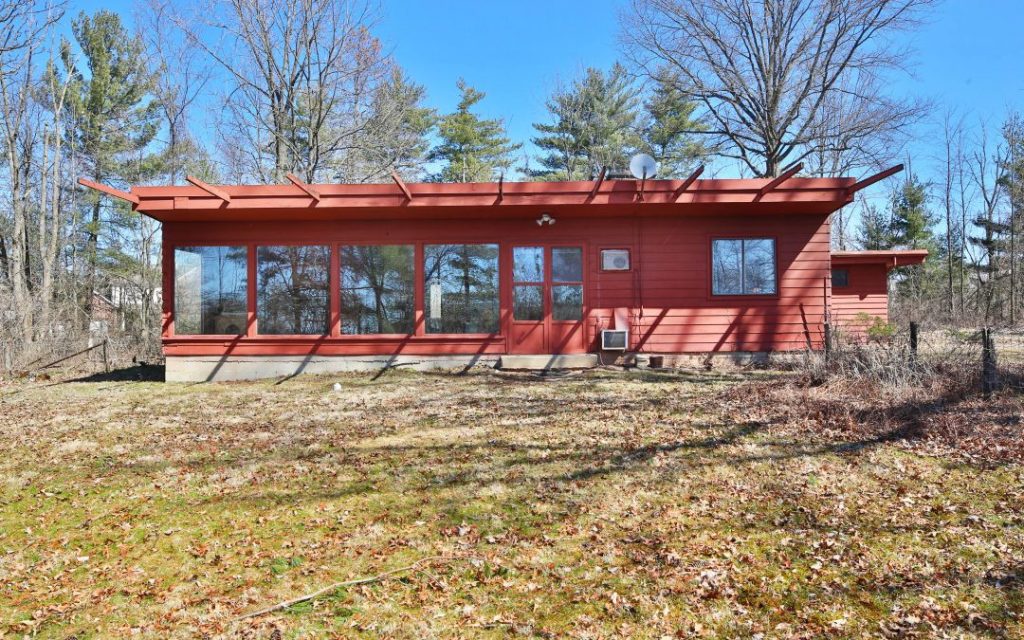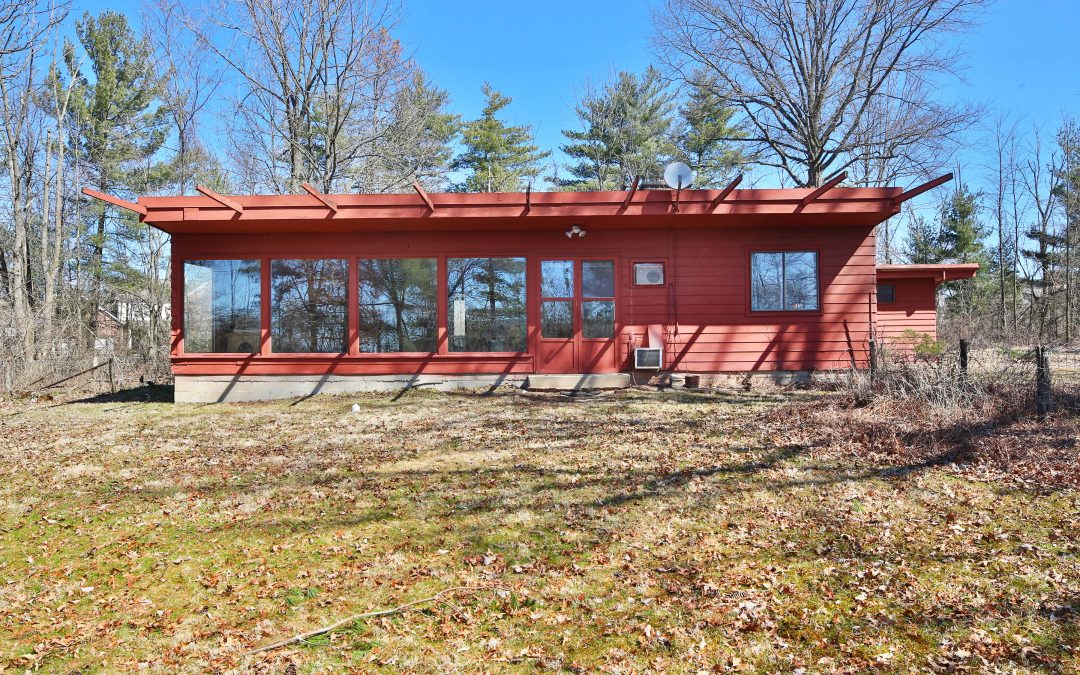Now offered for sale at $425,000
CLICK HERE FOR LISTING DETAILS
Columbus REALTORS® MLS 220016563
MODERN COLUMBUS REALTY collaborated with the Sterling Smith family and Nathalie Wright, a prominent Preservationist, to submit 655 McNaughten Rd. to the State Historic Preservation Office. On March 13, the National Register and Survey Manager issued a recommendation for nomination to the National Register of Historic Places. The Smith House and Art Studio would most likely be nominated under Criterion A: for its association with the artistic community in Columbus during the early to mid-twentieth century. The property is also likely to be eligible under Criterion C for its architectural significance as an intact example of the mid-century modern design esthetic.
While this recommendation does not guarantee placement on the National Register, it is the first required step in the process. The next owner will have an opportunity to pursue a historic designation and we hope they will preserve the residence and studio. This post includes edited excerpts from Wright’s submission and historic photographs, used with permission.
https://www.facebook.com/MODCBUS/videos/280608829521465/
History and Property Overview
https://www.facebook.com/MODCBUS/videos/1262855703896020/
Fall Foliage Video
Sterling Smith – Artist
 Frank S. Smith, who went by the nickname Pete, but used his middle name Sterling professionally, was a Columbus native. Smith’s family owned several acres along McNaughten Road, including an old farmhouse where he grew up. The farmhouse is still extant on the east side of the road. Sterling Smith attended the Ohio State University and trained as a pilot at the Boeing School of Aeronautics. He was a pilot for Pan-American Airways in the early 1940s, flying Miami to South American routes. He then moved to New York in pursuit of a painting career, where he was noted as devoting “much of his time to painting.” (Dispatch, 12/28/1952)
Frank S. Smith, who went by the nickname Pete, but used his middle name Sterling professionally, was a Columbus native. Smith’s family owned several acres along McNaughten Road, including an old farmhouse where he grew up. The farmhouse is still extant on the east side of the road. Sterling Smith attended the Ohio State University and trained as a pilot at the Boeing School of Aeronautics. He was a pilot for Pan-American Airways in the early 1940s, flying Miami to South American routes. He then moved to New York in pursuit of a painting career, where he was noted as devoting “much of his time to painting.” (Dispatch, 12/28/1952)
Returning to Columbus, Smith and his wife, Marjorie, were given several acres of land by his parents in April 1949, including the present parcel. Construction of the house and excavation of the pond began that summer, and a metal outbuilding was constructed in the spring. Painting in his art studio outbuilding, 1952 proved to be pivotal year for Smith. He had his first one-man exhibit at the Jewish Center in Bexley, and the Columbus Gallery of Fine Arts (now Museum of Art) purchased one of his paintings for its permanent collection.
Throughout the 1950s and 1960s, Smith also exhibited at the Columbus Art League, the Ohio State Fair, at libraries and galleries, and OSU. He was frequently mentioned in the art pages of the Columbus Dispatch. A July 24, 1955 article reported on his Hilltop Library Branch exhibit, stating “From the standpoint of modernism vs. realism, we suppose the Smith display must take a bow for greater latitude in the evolution of style…In the work of Smith, we know attention to ‘not quite traditional’ outbursts of color, with forms seldom clearly defined…As we examine his paintings of still life and landscapes, we have a feeling that we are enjoying the work of a knowledgeable painter who is likely to make an imprint on Ohio art.
In 1956, Sterling Smith’s work was represented in an exhibit of Columbus artists at the Columbus Gallery of Fine Arts. His art was displayed alongside other notable local artists, including Emerson Burkhart and Joseph Canzani, Dean of the Columbus Art School (now CCAD). He continued to have exhibitions in the late 20th century, including one at the Cultural Arts Center in 1982. Although considering himself retired, he painted into the 1990s. In 1994, the Columbus Museum of Art displayed three of his recent paintings, which were on loan to the institution. “A lot of [CCAD] students stop to look at them,” said Nannette Maciejunes, the museum’s acting curator. “They’re interested in the technical process involved in the development of the three.”
Smith was also an active member of the Columbus Art League. In 1960, he co-organized the League’s member exhibit, held at the Jewish Center. By 1961, he was an instructor at OSU’s School of Fine and Applied Arts, participating in the faculty exhibition that year. In addition to the Ohio State University, Sterling Smith taught art at the Columbus School for Girls and Sixpence School, which was a private school for the learning-disabled.
Smith House
 Sterling and Marjorie were good friends with Robert and Mary Gunning, who lived 3-1⁄2 miles away, farther east, off of E. Broad Street. Completed in 1940 and known as Glenbrow, the Gunnings commissioned a Modernist- Organic Architecture style house for their wooded ravine property. The design was completed by Ted van Fossen, Laurence Cuneo, and Tony Smith.
Sterling and Marjorie were good friends with Robert and Mary Gunning, who lived 3-1⁄2 miles away, farther east, off of E. Broad Street. Completed in 1940 and known as Glenbrow, the Gunnings commissioned a Modernist- Organic Architecture style house for their wooded ravine property. The design was completed by Ted van Fossen, Laurence Cuneo, and Tony Smith.
Family history has it that Sterling and Marjorie commissioned Tony Smith, a former Frank Lloyd Wright apprentice and site supervisor, for the design of their 1949 house. The two Smiths likely became acquainted through the Gunnings and possibly knew each other from New York City’s arts scene in the late 1940s. A family photo shows Tony Smith at the construction site in 1949. Reportedly, Tony Smith completed a design for Sterling and Marjorie, which initially placed the house on stilts. However, Mrs. Smith, pregnant with her first child, was adamantly opposed to the raised house. Due to the Smiths refusal of the elevated concept, there was a parting of ways, and the house was constructed based upon his design, minus the stilts. Warren L. Smith is listed as the architect on the plans, and currently, there is not definitive documentation that Tony Smith did indeed draw the initial design.
Warren L. Smith worked at the Columbus firm Benham, Richards & Armstrong, 1936-1950. Starting as a draftsman, he gained an architect’s license in 1947. In 1950, Warren L. Smith started his own firm, based in his Worthington home. Mostly working in Ohio, W. Smith completed a variety of residential designs, plus an OU sorority house, medical buildings, and schools. Two local school commissions include a remodel of Clinton in 1953 and an addition for Heyl Avenue, 1955. In 1964, he won a Columbus Junior League residential architecture award for 320 Medick Way for “expression of contemporary architecture combining building materials to give a feeling of lasting quality both in construction and design.” (Dispatch 5/24/1964)
The Smith House served as a summertime gathering place for some of Columbus’ well-known mid-20th century artists. After studying abroad following WWII service, artist Sidney Chafetz relocated to Columbus in 1948 to teach at OSU. He was an internationally known printmaker and established OSU’s printmaking program. He became a good friend of the Smiths, enjoying picnics at the country house. Ted van Fossen was also a regular guest.
Significance
The Sterling Smith house represents early residential Modernism in Columbus, as well as the link between the local creative community and architecture. Examples include:
 Robert Gunning, a newspaper reporter and writing consultant, commissioned Glenbrow in 1939.
Robert Gunning, a newspaper reporter and writing consultant, commissioned Glenbrow in 1939.
Frasier Reese, an artist and upholstery specialist, hired his brother-in-law, David Shackne to design a Modernist house in 1950. Located at 1330 Wilson Ave. amongst more traditional Colonial Revival houses, he created an early split level for Reese’s family. At the time, Shackne was still an architectural student at OSU, and he went to become the school architect for the Columbus City Schools, designing Whetstone High School.
Joseph Canzani, CCAD Dean, constructed a house in Rush Creek, 1957.
The original occupant of the Kytle House in Rush Creek, 1960, was a journalist/writer
The Cooper House, 1962, in Rush Creek included a built-in kiln for the owners, who were potters
Particularly in the case of the Gunning, Reese, and Sterling Smith houses, there is a noticeable local trend of young artistic adults, wishing for an avant guard home, taking a chance on equally young architects, who were just getting started in their careers. Rush Creek houses, as well as individual examples, were often constructed on less expensive land at Columbus’ fringes. Typically considered unsuitable for large-scale suburban developments, the lots were more affordable for struggling artists or young creative professionals just getting started. The site for the Sterling and Marjorie Smith House lacked the heavily wooded, hilly, or ravine setting of some of the other examples. However, this was compensated for by digging a pond near the house, which then became a landscape focal point for the property. Additionally, the Smiths planted vegetation and trees after the house was completed. In letters to his parents, Sterling Smith discusses the types of vegetation that he is considering for shade and to shield the house. For example, in a Christmas day letter, 1950, he specifically mentions planting “our beautiful tree” between the house and studio and includes a sketch.
The Sterling and Marjorie Smith House maintains historic integrity. Because they both lived there for decades, until their passing, the house looks remarkably like it did in 1949. Any changes to the property were completed by them. As the family grew with more children, there was a need for more bedrooms. In 1957 and 1959, bedroom wings were added to the house, creating an L-shaped configuration onto the original house. One of the hallmarks of Organic Architecture is the intent for houses to grow or change over time as a family changed. The Smith house reflects this basic idea, with its compatible, harmonious additions. Knotty pine replaced the drop ceiling in the kitchen and living room in the 1980s, but this alteration was completed by the Smiths and is in keeping with popular mid-20th century materials. Circa 2010, Marjorie Smith parceled off part of the pond to adjacent owners, but the pond retains its original configuration and size. Due to the Smiths’ efforts at shielding the property, vegetation is more densely crowded around the house, than when it was constructed.
This property, offered at $425,000, is an exclusive listing with Modern Columbus Realty. Contact Jason Hottle, Broker, for a private showing or additional information. Listing photos are available here.
Historic video, construction, and family photos used with the permission of Sterling Smith’s children for exclusive use by Modern Columbus Realty.
Additional images available in the GALLERY; (listing photos by Jeffrey T. Horvath Photography)


